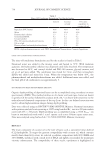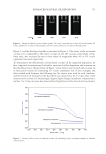647 WHAT CAUSES CURLY HAIR? themselves typed as ortho- or paracortical (or sometimes mesocortical). In high-curl wool fibers, such as those from the merino breed, the paracortical cells are clustered along the concave margin of the cortex, forming a strip with orthocortex on the convex side. The relation between cell type in low-diameter wools has become a definition applied to hair from other mammals. However, the direct transfer of wool cortical terminology to other hairs has been an oversimplification. In human, goat, alpaca, rabbit, deer, and higher- diameter sheep fibers (25–50 μm), cortical cell types can be ambiguous in both chemistry and structure, and single cells can contain macrofibrils of multiple architectures (10,17,32– 34). In particular, while the traditional view is that the intermediate filaments making up paracortical and mesocortical macrofibrils are arranged in parallel arrays, while those of the orthocortex are twisted into rope-like columns, recent studies show that the intensity of twisting varies. This variable twist means that many cortical cells contain features associated with both orthocortical and paracortical cell types. The details of cortical cell types are important because their organization not only correlates with curvature but has also been implicated as part of proposed mechanisms of curvature. Munro and Carnaby (35) developed a mathematical model that described how differential contraction of the cell types can explain fiber curvature in wool. Their hypothesis assumes that the fiber in the follicle is in a moisture-saturated state, and when the fiber dries during the transition to the mature state, the matrix located between intermediate filaments shrinks laterally. Because orthocortex is composed of helical wound ropes of intermediate filaments, lateral contraction should affect intermediate filament tilt and macrofibril length differently than in the paracortex. The resulting differential contraction then strains the fiber to curve toward the paracortex. With the Munro and Carnaby model in mind, studies on wool fibers have looked at differences between the orthocortex and paracortex using light and electron microscopy (13,36), atomic force microscopy (37,38), electron tomography (33,39,40), genomics (41,42), proteomics (43–47), microbeam small angle x-ray spectroscopy (48), elemental (49), and thermal analysis methods (50,51). The data have informed further models (52,53). Largely these studies have supported the models, but there have also been some findings that challenge the models, such as the discovery that macrofibrils can have variable tilt (46), that the proportion of orthocortex and paracortex does not correlate with curvature (13,51), and instead that the relative difference in length between orthocortical cells close to the outside of the curvature and paracortical cells close to the inside of the curvature correlates to curvature at that point in the wool fiber (13). Despite these new findings, the Munro and Carnaby–type models remain a good conceptual foundation for explaining curl in wool fibers. However, in human hair, the bilateral cell-type distribution is not typically observed in the cross-sectional images as it is in low-diameter wool fibers. Underlying this is the fact that cortical cell types are not as clearly differentiated in hair as they are in wool, and this occurs at the levels of macrofibril structure (33), cortical cell types and microscopy staining chemistry (33,39,54,55), and in intermediate filament angles (56). Historically, human scalp hair cortex has been described as the same as for wool (57,58), as orthocortex only (59), as like but not identical to wool (56,60), or using new terms (e.g., meta- or heterocortex) (61–64). Using a bespoke classification for human hair based on differences in macrofibril appearance using transmission electron microscopy, fluorescent stains, and electron tomography, Bryson et al. (39) demonstrated that differences analogous to those seen in wool in the cell-type distribution also occur in moderately curly and straight scalp
648 JOURNAL OF COSMETIC SCIENCE hairs. In the straight fiber, the cell types were arranged annularly and evenly within cortex, implying that the averaging of differing structural features would maintain a straight fiber conformation. In the curly fiber, the cell types were bilaterally distributed approximately perpendicular to fiber curvature direction. Previously, this pattern had only been observed in human scalp hairs with extremely high curliness (65). Among low-diameter mammalian hairs, fiber curvature is generally correlated to differences in cortical cell-type distribution across the cortex, with straight hair shafts containing an annular cell-type distribution and curly shafts a more bilateral distribution (46). WITHIN THE FOLLICLE Whatever the cause of curvature is at the level of the hair shaft, that cause originated in the hair follicle and resulted from a program of events that started within the living cells at the base of the anagen follicle bulb (24,66,67). Unlike correlations with curliness in the hair shaft, many of the correlations observed at the level of follicle structure have led directly to hypotheses of causation. It has been proposed that the shape of the hair follicles largely determines the shape of the fibers. Curly hairs from humans (regardless of ethnicity) and sheep typically emerge from curved follicle bulbs and straight fibers from relatively straight follicle bulbs (24). This has led to a common perception that hairs are extruded and take on the form of the follicle that produced them. In the middle of the 20th century, there was an awareness that follicles were in a dynamic state, mobilized by their arrector pili muscle (68). This led Chapman (69) to propose that muscle-induced rotation of the follicle bulb might cause hair shaft curl. However, the extrusion hypothesis is largely discounted based on more recent microscopy studies of follicles. Not only do follicles have a retrograde curvature (the bulb curves the opposite direction to the final fiber), but straight fibers have been observed growing from curved follicles in cultured bovine follicles, indicating that the correlation between follicle morphology and fiber curvature may be noncausative but associative (70). Rather than a cause, follicle bulb curvature may be a consequence of fiber development, such as different rates of protein expression across the cortex (71), cell reshaping and migration (72), or simply redistribution of stresses in a high-pressure biological environment (73). Other features that correlate with, or are associated with, follicles that generate curly hairs are differences in cortical keratin expression patterns (74) and in ultrastructural assembly of macrofibrils (75). Thibaut et al. showed using in vitro growth that curly hair is programmed in the basal area of the follicle, so asymmetry of keratinization was believed to result in a bilaterality of cell-type formation. Also associated with curly-hair–producing follicles is that the outer root sheath and the connective tissue sheath lack symmetry along the follicle (24). This is also known for wool, where the thicker outer root sheath associated with the concave curve of the follicle bulb is called the ental side and the other the ectal side of the follicle (68). Asymmetry of follicle morphology associated with hair curvature may have led Hynd et al. (76) to propose a model in which asymmetrical cell production on either side of the dermal papilla combined with a staggered initiation of keratinization and hardening on different sides of the hair shaft caused curvature. Work by Harland et al. (13) has challenged the role of asymmetric cell division as a cause of curvature in high-curl wool fibers, but the concept of staggered hardening remains intriguing. Further investigation tracking cells during
Purchased for the exclusive use of nofirst nolast (unknown) From: SCC Media Library & Resource Center (library.scconline.org)






































































































































